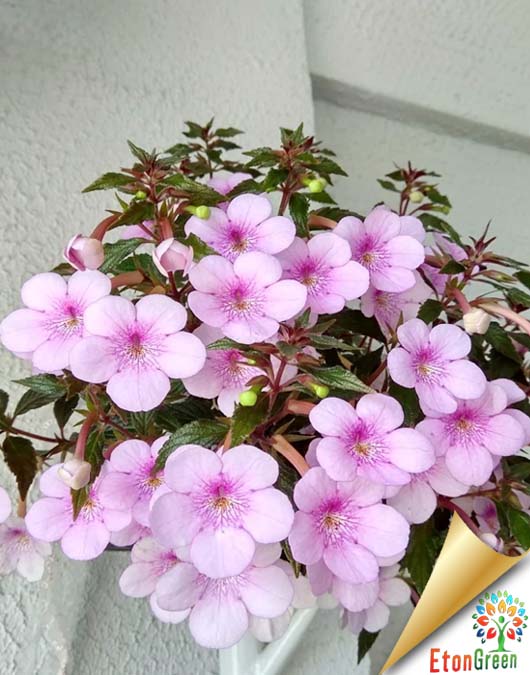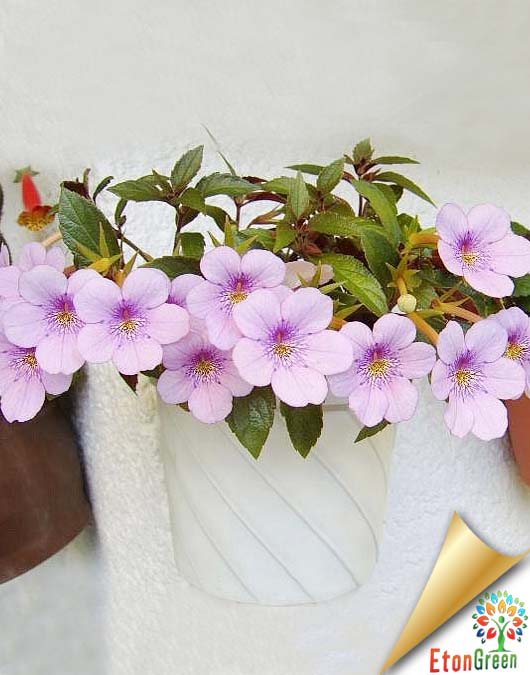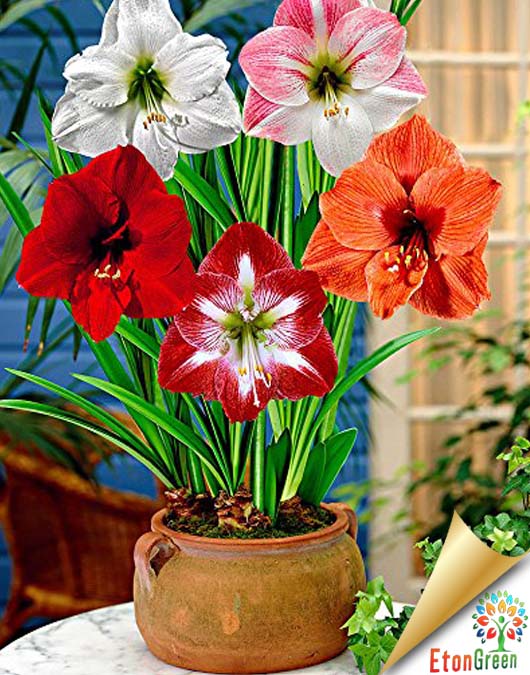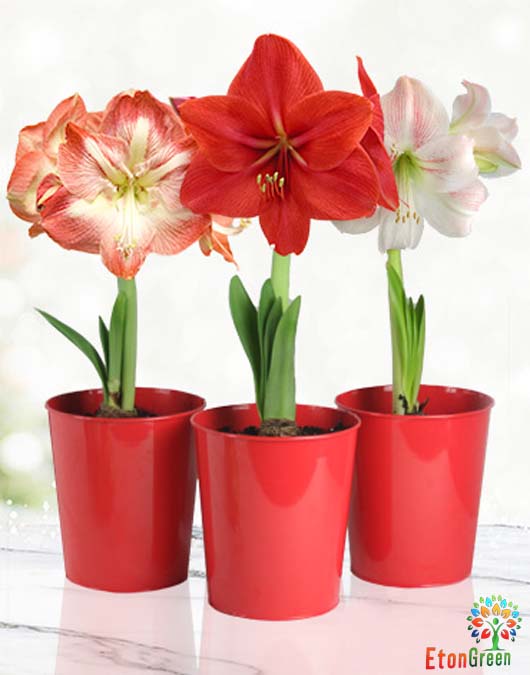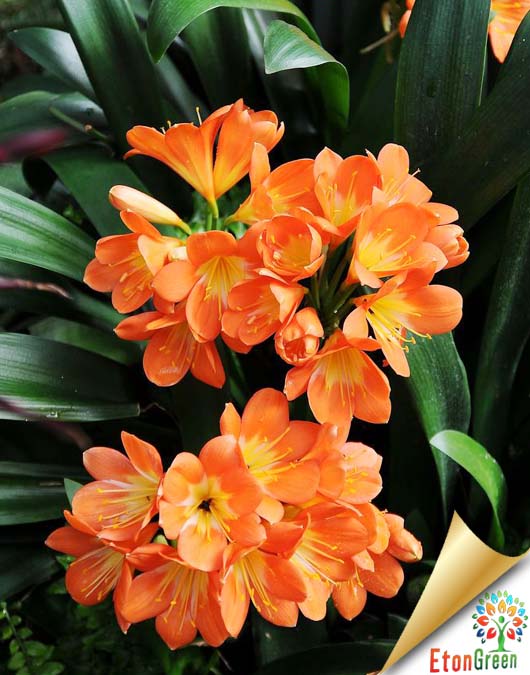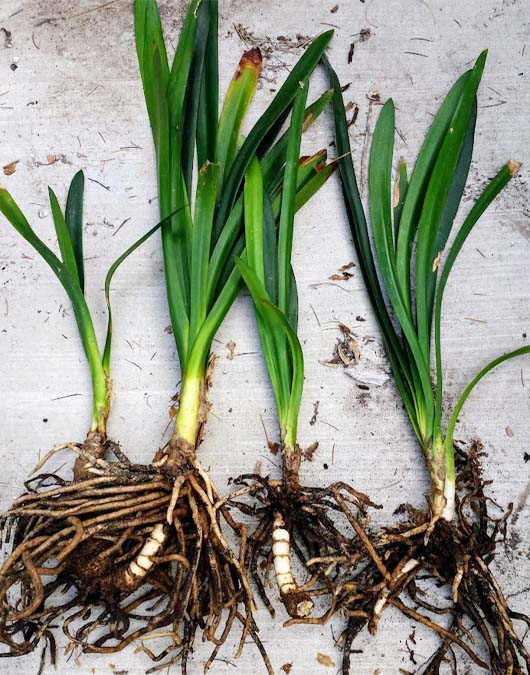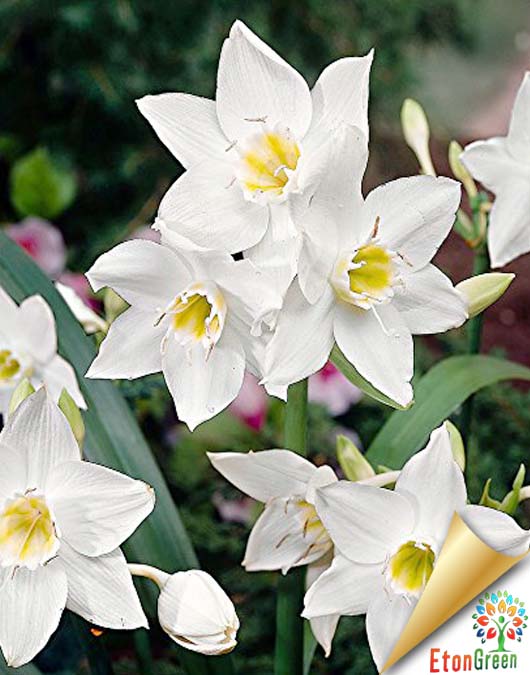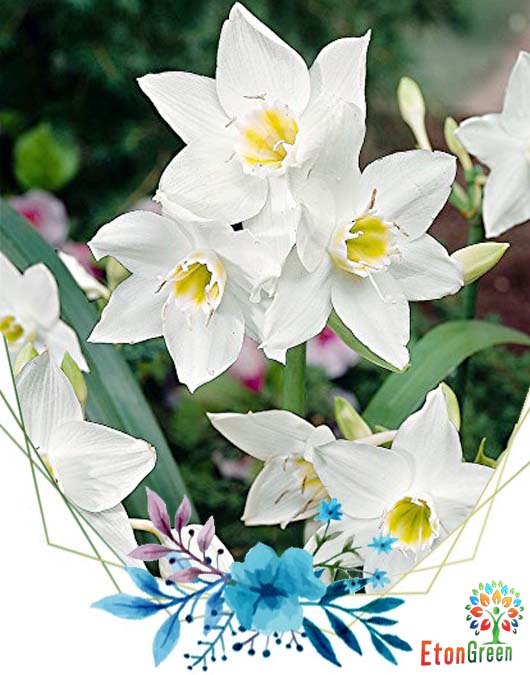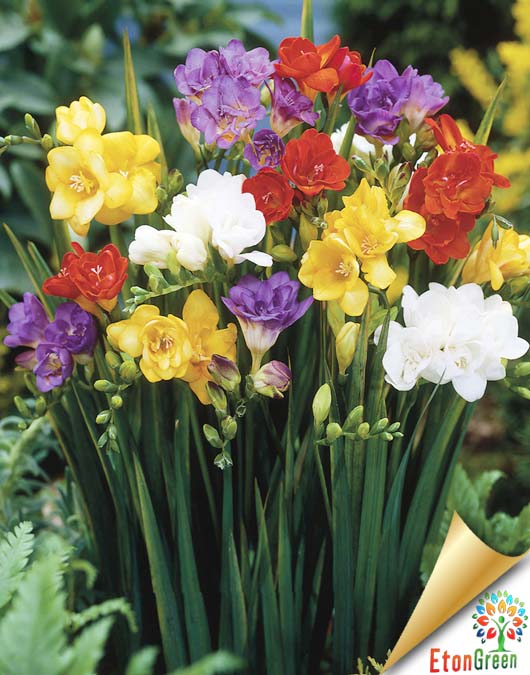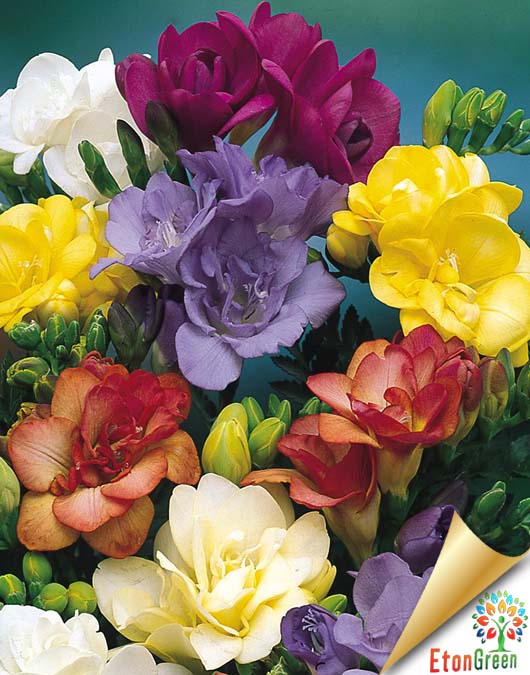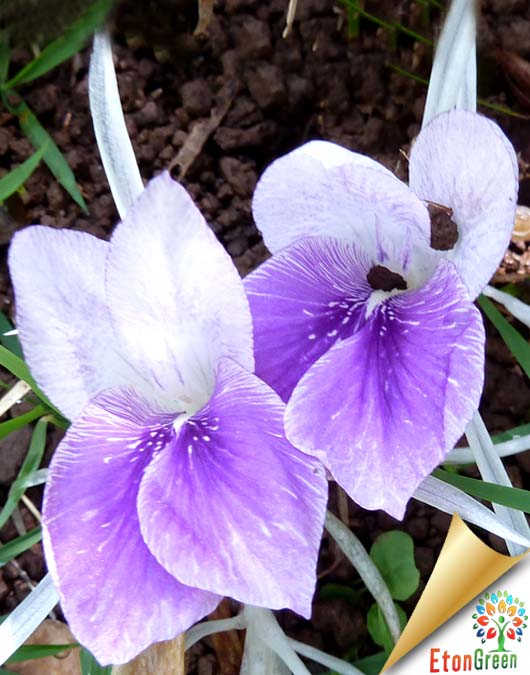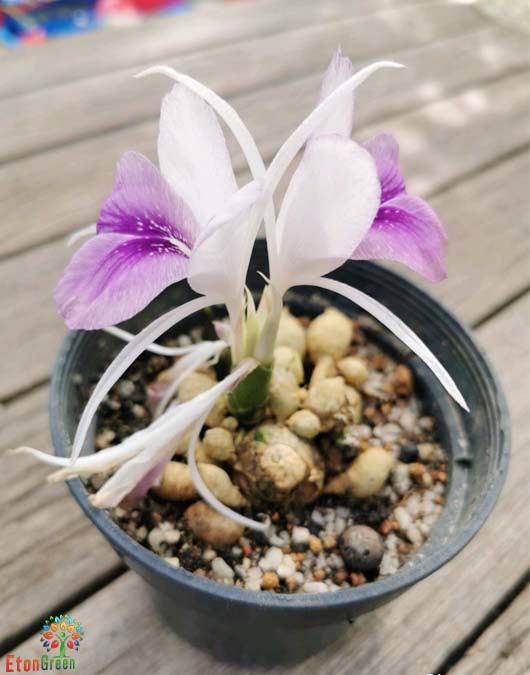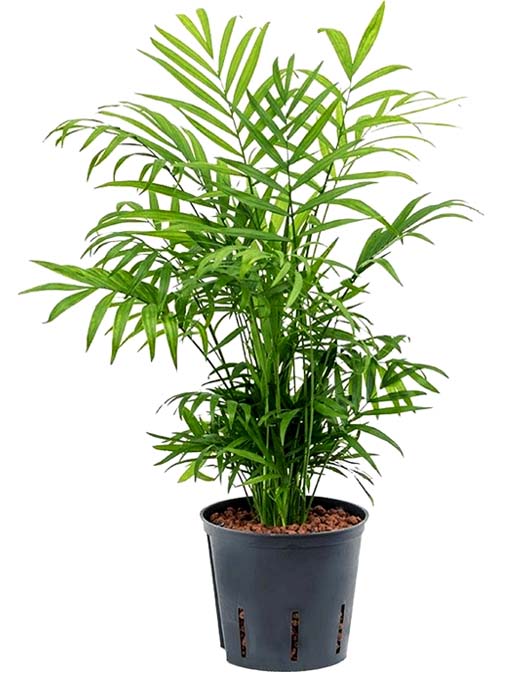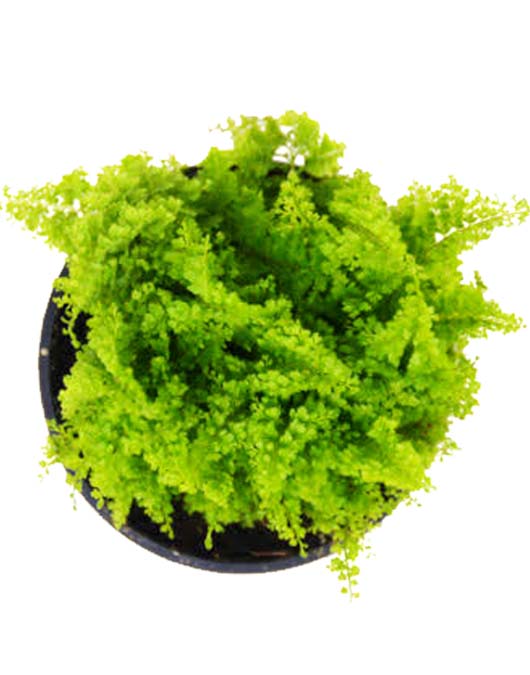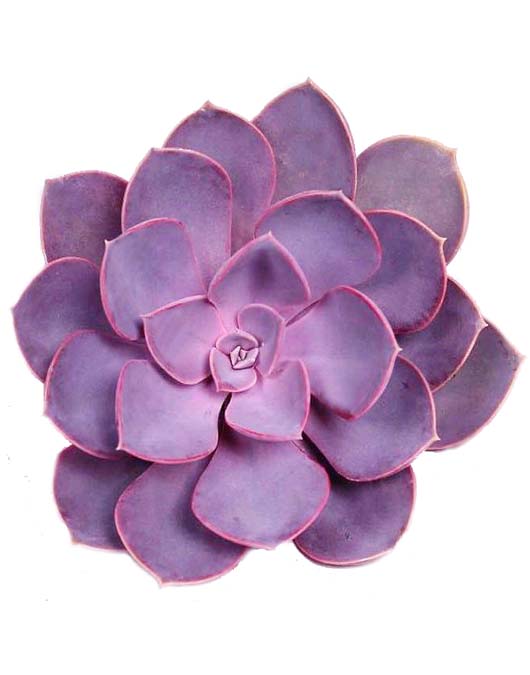- Shipping charge ₹ 90 for entire order
- These plants are perennial herbaceous bulbous plants. They generally have large fleshy bulbs. It is a plant with strap-shaped, glossy, green leaves and producing few large funnel-shaped flowers on a stout stalk, from March-May This plant is very suitable for planting in border, shrubbery and in a pot.
- The amaryllis lily is mainly used for ornamental purpose in garden, terrace, balcony, patio, etc.
- Common name: Hippeastrum
Color: The usual color is white with crimson veins, but pink or purple also occur naturally.
Bloom time: Late December until the end of June.
Height: 24 in/60 cm.
Difficulty level: EasyPlanting & Care
Amaryllis like their soil rich, but exceptionally well-drained, so ideally create a mix from one part well-rotted manure, one part horticultural grit or sand, and two parts leaf mould. Two-thirds good compost mixed with one-third grit also does fine.Sunlight: Full sunSoil: Well-drained soil.
Water: Keep soil moist throughout the growing season.
Temperature: 20°C
Fertilizer: Apply any organic fertilizer.
Harvesting: After the amaryllis has stopped flowering, it can be made to flower again. Cut the old flowers from the stem after flowering, and when the stem starts to sag, cut it back to the top of the bulb. Continue to water and fertilize as normal all summer, or for at least 5-6 months, allowing the leaves to fully develop and grow. When the leaves begin to yellow, which normally occurs in the early fall, cut the leaves back to about 2 inches from the top of the bulb and remove the bulb from the soil. Clean the bulb and place it in a cool (40-50 deg. F), dark place such as the crisper of your refrigerator for a minimum of 6 weeks. Caution: Do not store amaryllis bulbs in a refrigerator that contains apples, this will sterilize the bulbs. Store the bulbs for a minimum of 6 weeks.
Care:
- Once the plant is flowering, continue the watering and keep it out of direct sunlight, and slightly cooler (10-15°C), but as light as possible to promote a longer flower life.
- Each individual flower should last two or even three weeks before they brown.
- As each one fades, cut it off at the top of the stalk and then when the whole stalk is over and begins to sag, carefully cut it off just above the bulb nose.
- After flowering you can keep them from one year to the next.
- Feeding needs to continue and you want to water too, until the leaves begin to yellow in late summer/early autumn.
- At this stage, cut the leaves back to about 6cm (2½in) from the top of the bulb and remove it from the pot.
- Keep the bulb cool (5-10°C) and dark, to give it a dormant period for 8 weeks before you can encourage it to come into leaf and flower again When the temperature in your greenhouse falls to below 10C, bring them into the warmth and begin gentle watering again and your bulb will re-shoot.
- Don t re-pot it for the first couple of years; it hates root disturbance.
- The older and bigger the bulb, the more flowering stems you’ll get, so it’s worth the trouble of nurturing these mini football bulbs.
- Bulbs older than two years will produce offset bulblets.
- These may be left attached to the mother and re-potted with her, creating an amazing show, but its best to remove them carefully just before you replant and put them in their own individual pots.
- These little bulbs will take two years before producing their first flower, but it will be a proud moment when they do.
- Shipping charge ₹ 90 for entire order
- Its flowers are red, orange or yellow, sometimes with a faint, but very sweet perfume.
- Clivias are herbaceous plants with long, slender green leaves. The flowers, which can be yellow, orange or red, grow as individual blooms on the tip of an umbel, which stands as a hardy stalk above the green foliage below.
- These flowers have a bell shape to them and make for beautiful additions to a flower arrangement. Clivias do not form bulbs, but they do produce berries as fruits. It grows to a height of about 45 cm (18 in), and flowers are red, orange or yellow, sometimes with a faint, but very sweet perfume. It is sometimes known in cultivation as “Kaffir lily” (a term considered offensive in South Africa). The same name is also applied to the genus Hesperantha. It contains small amounts of lycorine, making it poisonous.
-
Sunlight These plants do best as part-time outdoor plants, spending the summers outside in a shady spot with no direct sunlight. Bring them in during the winter rest period and keep in a lit but cool location. Watering Suspend water during the winter and resume again in the late winter or early spring. Soil A standard potting mix should be fine. Temperature With a minimum temperature of 10 C (50 F) Fertilizer During the growing season, fertilize every week with a weak liquid fertilizer. It also works to include controlled-release fertilizer pellets in the soil.
Clivia is the ideal plant for the shade garden or for containers. It purifies the air.
- One adult plant can absorb one liter of impure air and release 80% of oxygen overnight
- It performs photosynthesis under very weak light
- 3-4 plants are enough in a room for absorbing smoke and other contaminants
Caution
All parts of the plant are slightly poisonous. Hence, the pot should never be placed within reach of small children and pets.
- Shipping charge ₹ 90 for entire order
- Eucharis lily (Eucharis x grandiflora) is a graceful bulb that produces fragrant white flowers similar in shape to daffodils. It is native to South America which explains it’s other common name – the Amazon lily.
- A bulbous Amazon lily is a low growing bulb producing star-shaped clusters of white flower.
- Eucharis is a perennial with a bulb 2 to 6 cm in diameter. The stalked leaves are 20 to 55 cm long and 10 to 20 cm broad. Flowers are large, sweet-scented.
- It likes shade and sheltered areas and makes an excellent potted plant
- It can be planted in the garden
- Plant them with their necks slightly above the soil surface
- Plant in a normal potting compost and plant at 3 to 4 cm
- Propagations by offsets can be done in the spring
-
Sunlight Bright light, partial shade Watering Medium Soil Sandy loam soil, well-drained soil Temperature 15 to 30 degrees C Fertilizer Use any organic fertilizer Harvest Season Spring (Flower & Bulb)
- Shipping charge ₹ 90 for entire order
- A wide range of colors and an alluring floral fragrance make freesia hard to resist. With up to eight trumpet-shaped, upward-pointing blossoms on leafless stems, freesias make delightful cut flowers that last a long time in the vase.
- The freesia bulb plant is easy to force indoors on sunny windowsills. Learning how to grow freesias in the garden and freesia flower care will allow you to enjoy these beauties year after year.
- Freesias bloom readily indoors. Plant the bulbs about 2 inches (5 cm.) apart in a pot filled with regular potting soil. Keep the soil moist, but not soggy, and place the pot in a sunny, preferably south-facing window. Expect flowers in 10 to 12 weeks.
- Once the flowers and foliage die back, allow the pot to dry out and place it in a cool location until you are ready to bring them into bloom again.
- Water well through the growing season but cut back during flowering time. Stop watering altogether once the foliage dies down and dries up. Do not over water because it will cause the corms to rot.
- Temperature: Keep Freesia refract plants in cool room with temperatures ranging between 16-18°C (60-65°F) and moderate humidity while they are growing and flowering. Blooms will last for weeks if kept at a maximum of 18°C (65°F). Freesia refract plants need a mild winter temperature of around 10°C (50°F).
- Fertilizer: A liquid fertilizer can be applied as soon as the first growth appears above ground.
- Shipping charge ₹ 90 for entire order
- Kaempferia plant blooms the fragrant flowers. Its flower emerges straight from the ground, even before the leaves appear.
- Kaempferia is a stemless plant producing a pseudo stem with 2 to 4 erect leaves from an underground rhizome that has small tuberous roots. Flowering stems are produced from the rhizome when the leaves are not present. Flowers resemble small orchids or African violets but have just three petals.
- Water a plant when the soil feels dry to touch
- Water thoroughly in the summer and reduce watering for the winter & rainy season
- Try to water the plants in the morning around 8-10am
- You should remove dead, infected or damaged plant parts and throw in the garbage collector
- You should fertilize a plant mostly in the spring season, flower bud stage
- Plant season is in monsoon or autumn season
- Plant the bulb 3 inches deep and provide 3 to 4 inches of planting spacing
- The pointy part should face up
- Add some coarse sand or fine gravel to the soil to help improve the drainage Mulch the potting mix with organic material
- The Parlour Palm was popular with the Victorians and remains a firm favourite. An elegant plant, easy to look after, with excellent air purifying qualities. They are undemanding in terms of light, water, temperature, humidity and feed, making them perfect for those of us that like low-maintenance room-mates.
- Chamaedorea elegans has bright green leaves on slender, arching stems. The leaves are pinnate, meaning it has feathered leaflets arranged on either side of the stem. With the Parlour Palm, these leaflets form opposite pairs and there can be as many as 40 leaflets on each leaf. Small yellow flowers appear on mature plants if they have sufficient light. Chamaedorea elegans also has the Latin name Neanthe bella. Its common names are Parlour Palm and Dwarf Mountain Palm.
- Common Name : Parlor Palm, Neanthe bella palm Botanical Name : Chamaedorea elegans
- Among all the palm trees, parlor palms are a great place to start for the beginner.
- Plant Will Be Given With Free Plastic Pot
- The cotton candy fern plant’s Latin name is Nephrolepis exaltata.
- Nephrolepis Exaltata ‘Cotton Candy’ is a lusciously thick evergreen fern with beautiful sword-shaped leaves.
- The Cotton Candy fern has many soft and fluffy light-green leaves that flare up and outward as they grow.
- Plant Will Be Given With Free Plastic Pot
- Echeveria Perle von Nurnberg is an evergreen succulent, It is a very popular hybrid succulent of Echeveria gibbiflora ‘Metalica’ and Echeveria elegans .
- The hybrid was created by Richard Grassner in Germany during the 1930s. It is popular among plant lovers due to its unique two-toned, pink highlights and white powdery dusting appearance
- Echeveria Pearlvon is a popular Hybrid and one of the most Beautiful of All Echeveria Plant.
- It has pink flowers with yellow interiors that bloom in the summer. If there are dead leaves on PVN, it is best to remove them quickly, as they can attract pests
- These Plants have moderate light needs. It can handle partial shade to full sun (gives best color) and should ideally get at least six hours of sun a day.
- Echeveria ‘Perle von Nurnberg’ has typical watering needs for a succulent
- Plant Will Be Given With Free plastic Pot

